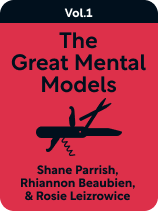

This article is an excerpt from the Shortform book guide to "The Great Mental Models Volume 1" by Shane Parrish and Rhiannon Beaubien. Shortform has the world's best summaries and analyses of books you should be reading.
Like this article? Sign up for a free trial here.
What’s Occam’s Razor, and how can it help you solve problems in life? What should you do if you’re not operating in your “region of mastery”?
The Great Mental Models Volume 1: General Thinking Concepts presents a foundational set of nine mental models. According to authors Shane Parrish and Rhiannon Beaubien, these models are timeless thinking tools from a variety of fields.
Keep reading to learn how these models can equip you to make better decisions, avoid consequential mistakes, and succeed in life and work.
The Great Mental Models Volume 1
Each day, we face difficult decisions. At the same time, the world moves so fast that we often lack a clear view of the problems we face. In The Great Mental Models Volume 1: General Thinking Concepts, the authors argue that, in the face of this complexity and uncertainty, we can navigate tough decisions using mental models—simple mental representations of how things work—that help you cut through complexity and understand the world.
The next two volumes of The Great Mental Models build on the first, which introduces the premises and purpose of the series. Volume 2 continues with mental models from physics, chemistry, and biology, and Volume 3 describes models from systems thinking and mathematics.
Parrish and Beaubien, both former Canadian intelligence agents, are the founder and content strategist (respectively) of the Farnam Street blog, where they write about mental models, decision-making, and the pursuit of wisdom. In this guide, we’ll explain their view of mental models—what they are, how they work, and why they matter—and we’ll introduce the nine models they present.
What Mental Models Are and How They Work
To begin, we’ll explain the authors’ approach to mental models. We’ll describe what a mental model is and describe why you need them, and we’ll discuss the type of models that the authors chose for Volume 1 of The Great Mental Models.
Put simply, a mental model represents how something works. According to the authors, mental models are time-tested ways of thinking that help us break down and solve complex problems. According to the authors, mental models make you a better decision-maker in life and work because they enable you to understand why things happen in the ways they do and therefore be able to predict what will happen next.
In Volume 1, the authors focus on broad thinking tools that don’t fall into any specific field, opting instead to begin with a well-rounded repertoire of mental models that capture humanity’s best, time-tested wisdom.
With that, let’s take an introductory look at the authors’ nine foundational mental models.
Group #1: Elemental Models
To begin, the authors introduce three elemental models that apply to many situations. These first models expand upon and demonstrate the authors’ notions of what mental models are and how they work:
- Models #1 and #2 explain the limitations of models and how to know where to start.
- Then, Model #3 illustrates the preceding two concepts with a simple distinction between territory for which you do versus don’t have good models.
Altogether, these broad “meta-models” will help you think more clearly about each successive model.
Model #1: Know That Maps and Models Have Limitations
First, the authors explain how to think about mental models as maps. To use them effectively, remember that maps aren’t literal pictures of the territory they describe, nor do they provide every piece of information available about that territory.
Limitation #1: Maps are time-bound. We make maps at certain points in time, but maps don’t automatically change as the world does. This means that maps go out of date.
Limitation #2: Maps are reductions. Remember that the territory and its map are different—many things have been excluded from the map that you’ll run into in real life. If you forget this, the authors say that you risk dogmatically forcing your maps to “work,” even when they no longer fit reality.
Model #2: Know Where to Start
When examining any problem, start with the basic facts or bedrock assumptions of the discipline or field. These are called first principles—in other words, the fundamentals of the discipline or domain. According to the authors, starting from the fundamentals enables you to think for yourself. If you start from the bedrock facts, you can devise solutions that are independent of cultural conventions.
Model #3: Know Your Strengths
Knowing whether you’re in a region of mastery or if you should seek support allows you to avoid blunders and make better decisions. In turn, this helps you learn, grow, and succeed more in life and work. According to the authors, that’s where your weaknesses are—areas where you’re more likely to make mistakes. When you’re outside your regions of mastery, remember that you know less than you might think.
Group #2: Models for Basic Systems Thinking
Moving beyond the introductory models, the authors’ next three models concern basic systems thinking. Parrish and Beaubien stress that we live in an interconnected world, and these models offer ways to think through, predict, and evaluate options in light of this interconnectedness. By understanding how your choices have ripple effects, you can avoid negative downstream consequences and ensure better outcomes for each decision you make.
Model #4: Consider the Consequences
Since anything you do has downstream effects, consider the immediate and secondary effects of any choice. According to the authors, many decisions that have immediate positive results have negative consequences down the road. By thinking ahead, you can predict and prevent unwanted outcomes.
The authors describe two lessons you can learn by considering consequences:
Lesson #1: Short-term benefits often have long-term consequences.
Lesson #2: Explaining ripple effects makes you more persuasive.
Model #5: Consider the Chances
Considering the chances helps you determine which possibilities are most likely to happen. The authors recommend using probability techniques to explore the most likely consequences of a decision. They explain three forms of probabilistic thinking:
#1: Bayesian thinking: This involves evaluating new information in light of what you already know and being willing to update your beliefs when you receive new information.
#2: Fat-tailed curves: Some domains fit fat-tailed curves (as opposed to normal distribution bell curves). Fat-tailed curves are more prone to extreme outlier events.
#3: Asymmetries: We often overestimate how accurate our probability estimates are, so we should remember that we’re biased to think more highly of ourselves.
Model #6: Consider the Possibilities
The authors say that, for problems that you can’t test directly, thought experiments allow you to consider all of the possibilities. A thought experiment is an imagined scenario or hypothetical situation that you test with your mind’s eye. In other words, you use imagination to rigorously explore what’s possible.
Group #3: Problem-Solving Rules of Thumb
In this final section, we’ll pivot away from systems-thinking models to present the authors’ final three models—Occam’s Razor, Hanlon’s Razor, and inversion. Each of these models is a self-contained “rule of thumb” for solving tough problems. When applied correctly, they slice through complications, eliminate mental clutter, and help you home in on clear answers.
Model #7: Occam’s Razor
Simply put, Occam’s Razor states that the simplest explanation is most often the best explanation. Given various solutions to a problem, all of which solve it equally well, you should favor the simplest answer.
Model #8: Hanlon’s Razor
Much like Occam’s Razor, Hanlon’s Razor quickly cuts through complicated explanations. In short, it states that the most likely explanation involves the least ill intent. According to the authors, bad things usually result from ignorance or a lack of thought, rather than malice. The authors recommend using Hanlon’s Razor to realize that the world contains more chaos than evil.
Model #9: Inversion
As a thinking tool, to invert is to approach a problem from the end you typically don’t consider. The authors explain that we tend to approach challenges directly: by looking at the problem first and then searching for the solution. However, the direct approach sometimes fails, especially when the problem demands a creative or counterintuitive solution. When it does, try looking at the problem from the opposite angle that you started from.
The authors outline two ways to use inversion:
#1: Assume success, then analyze what else would have to be the case. For instance, if you’d like to become more fit, you might begin with the “assumption” that you’ve built your ideal body, and then think about what lifestyle factors you changed to get there. Use these answers to guide you.
#2: Practice avoidance instead of pursuit. For example, you could minimize the risk of business failure by studying companies that failed, figuring out what caused their failures, and eliminating those factors from your business—in other words, minimize risk instead of pursuing advantages.
Exercise: Start Developing Your Mental Models
The authors emphasize that mental models are tools for making better decisions. Practice using mental models to aid your decisions by applying three to a situation you’re currently experiencing.
- Considering the authors’ nine foundational mental models, pick three mental models that you could implement today. Briefly describe how you might use each.
- Now, take your first mental model and put it into action. Bring to mind a situation you’re currently in and, using the mental model, briefly write down any insights it gives you. For instance, you might “consider the consequences” of your current spending habits.
- Taking your second model, try applying it to the same situation. Describe what the model helps you see about the situation. For example, you might ask whether personal finance is one of your regions of mastery—and how you might make it one.
- Last, use your third model to look at the situation from a third perspective. Briefly reflect on what the model reveals, and how you could act from there. For instance, you could look for the fundamentals of personal finances and, with those first principles, devise new spending habits.

———End of Preview———
Like what you just read? Read the rest of the world's best book summary and analysis of Shane Parrish and Rhiannon Beaubien's "The Great Mental Models Volume 1" at Shortform.
Here's what you'll find in our full The Great Mental Models Volume 1 summary:
- What mental models are and how they work
- How to make better decisions by using mental models
- How to use your imagination to evaluate your choices






